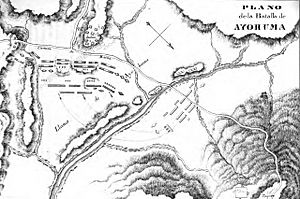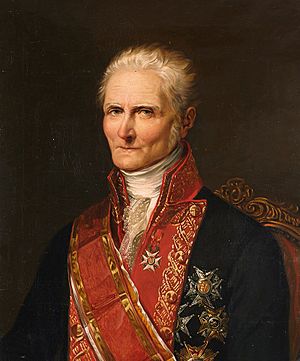Battle of Ayohuma facts for kids
Quick facts for kids Battle of Ayohuma |
|||||||
|---|---|---|---|---|---|---|---|
| Part of Bolivian War of Independence Argentine War of Independence Spanish American Wars of Independence |
|||||||
 Old map of the battle |
|||||||
|
|||||||
| Belligerents | |||||||
| Commanders and leaders | |||||||
| Strength | |||||||
| 3400 soldiers 8 cannon |
3500 soldiers 18 cannon |
||||||
| Casualties and losses | |||||||
| 300 dead 200 wounded 600 prisoners |
42 dead 96 wounded |
||||||
The Battle of Ayohuma was an important fight during the Spanish American wars of independence. It happened on November 14, 1813. The name "Ayohuma" means "dead man's head" in the Quechua language.
In this battle, the Royal Army of Viceroyalty of Peru won. Their leader was General Joaquín de la Pezuela from Spain. They defeated the Army of the North, which was led by General Manuel Belgrano. This was part of the second campaign in Upper Peru during the Argentine War of Independence.
Contents
What Led to the Battle?
Rebuilding the Patriot Army
After a tough loss at Vilcapugio on October 1, 1813, General Belgrano needed to rebuild his army. He set up his main camp at Macha. He got help from different areas in Upper Peru.
By the end of October 1813, Belgrano's Army of the North had about 3,400 soldiers. Only about 1,000 of these were experienced fighters. The rest were new recruits or people from the local population.

Royalist Challenges and Movements
Even though General Pezuela's royalist troops had won the last battle, they faced problems. They didn't have enough horses, mules, or supplies. They had found a safe spot on the Condo-Condo heights.
The royalists were surrounded by people who didn't support them. They were also still recovering from their own losses at Vilcapugio. This made it hard for them to attack Belgrano's army right away.
However, on October 29, Pezuela's army left their camp. They wanted to attack the patriots before they could get more help. On November 12, they reached Toquirí, a mountain near the small plain of Ayohuma.
Belgrano's Decision to Fight
Meanwhile, Belgrano's camp was only a short distance from Toquirí. On November 8, Belgrano talked with his officers about their next steps. Most of them wanted to pull back to Potosí.
But General Belgrano convinced his officers that they should fight. That night, the army left Macha. They arrived at Ayohuma the next morning, ready for battle.
The Battle of Ayohuma
Unequal Forces
The two armies facing each other were not evenly matched. Belgrano's army had more cavalry (soldiers on horseback). But Pezuela's royalist army had twice as many infantry (foot soldiers).
Pezuela also had a lot more artillery, with 18 cannons. Belgrano's troops only had eight smaller, short-range guns. This difference in firepower would be very important.
Royalist Strategy and Attack
On the morning of November 14, the royalists began to move down from their high position. By mid-morning, they had spread out their main forces on the plain. Belgrano's troops were attending Mass, even though they knew the enemy was moving.
An hour later, Pezuela finished his plan. Instead of attacking straight on, the royalist army went around the patriots' right side. They crossed some hills that hid them from Belgrano's view. This forced Belgrano to quickly move his troops to face them.
The Fight Begins
This smart move by Pezuela was a key moment in the battle. Then, Pezuela's cannons started firing. Their powerful shots created gaps in the patriot lines. Belgrano ordered his infantry and cavalry to charge towards the enemy.
But the ground was rough, and Pezuela's defenses were strong. Belgrano's smaller guns were no match for the royalist artillery. The patriot army was taking heavy fire.
Patriot Retreat and Heroes
Belgrano had no choice but to order a retreat. He used a trumpet call and waved the United Provinces flag from a hilltop. He managed to gather about 500 of his men.
The battle lasted seven hours. The patriots lost about 300 soldiers who died, 200 who were wounded, and 600 who were taken prisoner. They also lost almost all their cannons.
Many brave people fought in this battle. Colonel José Superí, who led the "Castes' Battalion" (made of soldiers of African and mulatto descent), was killed by royalist cannons. José María Paz, an officer who became famous later, had to rescue his brother, Captain Julián Paz.
Colonel Cornelio Zelaya, a skilled cavalry officer, fought at the back of the army. This allowed most of Belgrano's forces to retreat in an orderly way. Three brave women, María Remedios del Valle and her two daughters, became known as the Niñas de Ayohuma ("Maidens of Ayohuma"). They brought water to the soldiers and helped the wounded during the heavy fighting.
What Happened Next?
Retreat and New Command
Belgrano's 500 surviving soldiers retreated to Potosí. However, they had to leave the city quickly on November 18. This was because the royalist forces were getting close.
Belgrano then moved his army back to Tucumán. On January 30, 1814, he gave up command of the Northern Army. The new leader was General San Martín. Belgrano later wrote that the Spanish officers were better at warfare than he was.
See also
 In Spanish: Batalla de Ayohuma para niños
In Spanish: Batalla de Ayohuma para niños
- Battle of Pequereque
- Battle of Vilcapugio
- Action of Tambo Nuevo
- Flag of Macha


